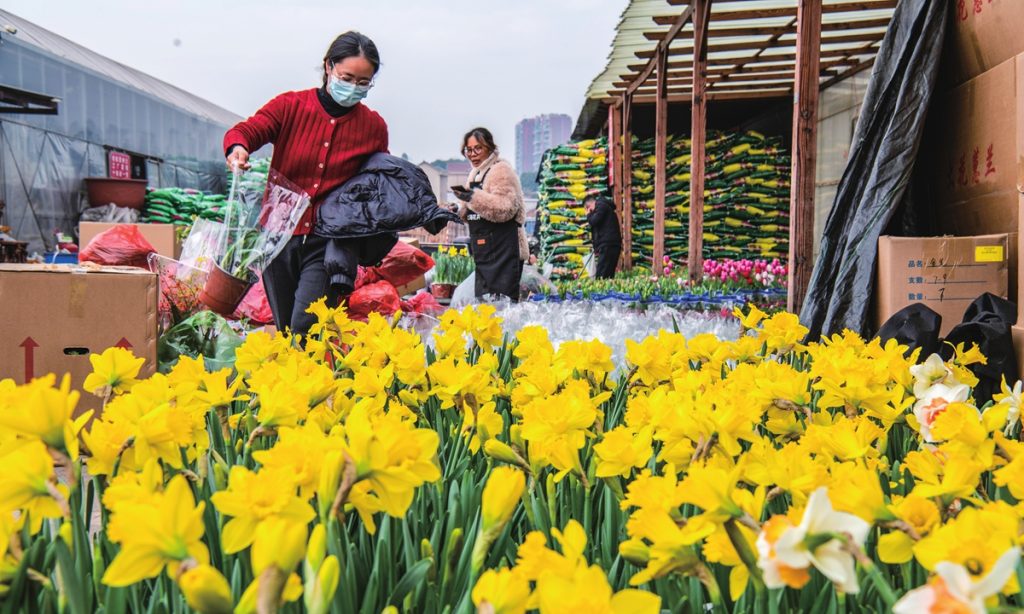WIPO official, experts analyze how China's innovation capability continues to make steady progress amid global instability

In the face of the major opportunities and challenges brought about by a new wave of technological revolution and industrial transformation, innovation has become a topic of particular concern for all countries as it is a key factor in pushing forward a country's continued development.
In September 2023, the World Intellectual Property Organization (WIPO) released the "Global Innovation Index (GII) Report 2023." The report showed that China, Turkey, India, Vietnam, the Philippines, and Indonesia are the middle-income economies that have made the most headway in innovation over the last decade. Among them, China is the only one that ranked among the top 30.
"China is far ahead in global innovation performance; it is close to the top 10 of the GII ranking and still the sole middle-income economy within the GII top 30," Sacha Wunsch-Vincent, head of the section of Economics and Statistics Division, and co-editor of The GII at the WIPO, told the Global Times in an exclusive interview.
A close look at the GII reports revealed that since the first release of the GII report in 2007, China's overall ranking has shown a steady upward trend. In this year's ranking, China ranks 12th, having climbed 31 spots from its lowest ranking in previous years (43rd in 2010). The report also specially mentioned that China is the only middle-income economy among the top 30, followed by Japan in the 13th place.
Steady progress in innovation
Data in the GII report showed that in 2023, China ranked first globally in six specific indicators, including the proportion of creative goods export in total trade volume, domestic market scale, labor productivity growth rate, PISA scales in reading, math, and science, the ratio of trademarks by origin to GDP, and the ratio of utility models by origin applications to GDP.
"The GII rankings are compiled based on about 80 indicators which can be gleaned from the country profiles. The indicators are structured around innovation input and innovation output dimensions and cover fields such as human capital, research and development, venture capital, high-tech manufacturing, and patents, but also rank intangible assets and creative goods and services," Wunsch-Vincent explained.
A special excerpt from the GII also showed that the world's five biggest science and technology (S&T) clusters are now located in East Asia, with China emerging as the country with the greatest number of clusters as Tokyo-Yokohama leads as the biggest S&T cluster.
"The emergence of Chinese top science and technology clusters does not come as a surprise with all the science and innovation activity that has propelled China forward in the GII. It is impressive nonetheless - some of the top-ranked cities or regions are obvious leaders such as around Beijing or Shanghai," Wunsch-Vincent noted to the Global Times.
"In addition, there are many cities or clusters emerging, which are new and not that well-known yet as science and technology hubs around the world. In that sense, the ranking also allows the rest of the world to better understand the geography and potential of innovation in China," he said.
Feng Xingke, secretary general of the World Financial Forum and director of the Center for BRICS and Global Governance, told the Global Times that this reflects the shifting of the global center of technological activities to the East, with East Asia leading global technological innovation.
"The increase in the number of Chinese technology clusters is mainly due to China's continuous strengthening of regional technological innovation development strategies in recent years, forming an ecological system for technological innovation with central coordination, local healthy competition, and mutual development," Feng said.
Analysts generally believe that China has made remarkable achievements in the fields of new energy, high-speed rail, modern information, new materials, and artificial intelligence, and related new industries and products have shown strong growth momentum.
Feng pointed out that one important reason for China's innovation progress lies in the strong support from the government.
In recent years, the Chinese government has invested a large amount of funds in major scientific and technological innovation research and development, and has provided a favorable policy and business environment for scientific and technological innovation, strengthened the team of scientific and technological innovation talents, and laid a solid foundation for technological innovation progress, he said.
In a previous interview with the Global Times, Manuel C. Menendez, founder and CEO of MCM Group Holdings, hailed the great achievements that China has made over the last decade.
He noted that in addition to the country's policy, it is necessary to give credit to Chinese entrepreneurs and China's ability to take a policy and make it work step by step.
According to Wunsch-Vincent, an important reason for China to progress rapidly is that China has "prioritized innovation and science and technology policy as a means to achieve economic growth and development for many decades now. It has consistently increased its innovation expenditures and has built an impressive innovation ecosystem."
"I also believe that China has a dynamic start-up scene with abundant young and highly skilled human capital. These factors have helped China achieve the rise that the GII describes, and to stand out among other middle-income economies," he noted.
China has a long tradition of placing high emphasis on innovation and the capability to turn applications into industrial development. China is also sharing its outcomes from scientific development with other regions of the world, which experts pointed out will help facilitate global development.
For example, in November 2023, China hosted the first Belt and Road Conference on Science and Technology Exchange in Southwest China's Chongqing Municipality. China has signed intergovernmental science and technology cooperation agreements with more than 80 Belt and Road Initiative (BRI) partners, jointly building a comprehensive, multi-level, and wide-ranging science and technology cooperation pattern, Xinhua reported.
"China's growth - both economic and also innovation-wise - is significant both for the world and the wider region. China has made notable strides in innovation in fields such as information technology, health, electric vehicles and batteries with commercialized products, and nanotechnology or other deep science fields," Wunsch-Vincent said.
However, several experts also noted to the Global Times that such innovation in China also faces increasing challenges as some people in the West actively call for so-called "technological decoupling" from China.
"China should establish an open international cooperation mechanism for scientific and technological innovation and clearly oppose 'technological decoupling.' It is necessary to build a systematic, multi-level, comprehensive, and targeted international strategy for scientific and technological innovation cooperation," Feng told the Global Times.
"China should continue to strengthen innovation cooperation with the US, deepen scientific and technological cooperation with Russia, make good use of European scientific and technological innovation resources, seize opportunities for innovation cooperation with Japan and South Korea, and actively participate in the formulation of international regulations for emerging technologies," Feng said.
Middle-income economies full of development potential
The GII, launched in 2007 and is now in its 16th edition, takes the pulse of innovation by tracking the most recent global innovation trends and benchmarking about 130 countries worldwide and the top 100 science and technology clusters on their innovation performance.
With the theme "Innovation in the Face of Uncertainty," the GII 2023 report used the average of the input and output sub-indices to track the global state of innovation. The highlight is that innovation investments showed mixed performance in 2022 within a context of many challenges and a downturn in innovation finance, Wunsch-Vincent said.
According to Wunsch-Vincent, in 2023, global scientific publications, research and development (R&D), venture capital (VC) deals, and patents continued to increase more than ever. However, growth rates were lower than the exceptional increases seen in 2021. In addition, the value of VC investment declined and international patent filings stagnated in 2022. In particular, reflecting a deteriorating climate for risk finance, the value of VC investments declined sharply in 2022 from an exceptionally high level in 2021. And the VC volumes declined by over 30 percent in 2023 relative to 2022, and are expected to be only half of the amount invested in the VC boom year of 2021.
Wu Jinxi, Director of the Strategic Emerging Industries Research Center at the School of Social Sciences of Tsinghua University, told the Global Times that in the face of global issues such as rising R&D costs and slowing patent growth, the efficiency of scientific research and innovation system should be improved first, and scientific research resources should be allocated reasonably, "putting money where it matters most."
Despite downward pressure on the global economy, countries should not reduce investment in scientific research, he said.
However, many experts and analysts from various countries also see the current situation of opportunities and challenges coexisting. The 2023 GII report shows that the innovation performance of middle-income economies as a whole is quite remarkable. In the last decade, China has become the fastest-growing middle-income economy on the GII rankings along with Turkey, India, Vietnam, the Philippines, Indonesia, and Iran.
A total of 21 economies, mostly in sub-Saharan Africa, Southeast Asia, East Asia, and Oceania, are rated by the report as "exceeding expectations" in terms of their innovation performance relative to their level of economic development. India, Moldova, and Vietnam have outperformed expectations for 13 consecutive years.
According to Feng, the reason behind these economies' performance exceeding expectations is mainly the world governance pattern of globalization and multilateralism. In the context of the new round of scientific and technological revolution, the transformation and upgrading of traditional industries and the development of emerging industries have provided a historic opportunity for developing economies to catch up with developed economies in new areas, he noted.
Compared with Western countries using technological monopoly advantages to contain developing countries and emerging economies, China is more willing to share innovative technologies through technology transfer or joint development said Liang Zhihua, president of Southeast Asia Social Science Research Center.
Liang believes that with the export and sharing of China's scientific and technological innovation, the digital transformation of middle-income and emerging economies, including Malaysia, will further be propelled.
Wunsch-Vincent noted that the GII report is a "tool for action" regarding innovation policy for governments around the world. A survey carried out by WIPO in 2022 showed that 70 percent of WIPO member states were using the GII to improve innovation ecosystems and metrics, as well as being a benchmark for national innovation policies or economic strategies.
In Feng's view, middle-income economies have the corresponding economic strength, scientific and technological foundation, and late-comer advantages, and have the opportunity to become a new engine of global innovation, but this is not an inevitable result.
"Only by balancing the relationship between the government and the market, formulating sound industrial and financial policies, building a market-oriented, legalized, and internationalized business environment, and stimulating the motivation and vitality of enterprises to innovate through market mechanisms can middle-income economies be expected to become the main force of innovation," he said.







